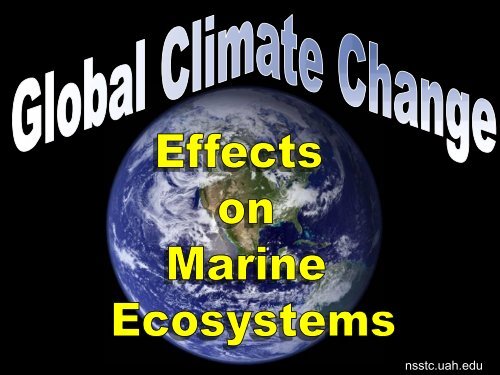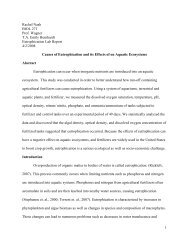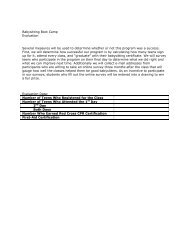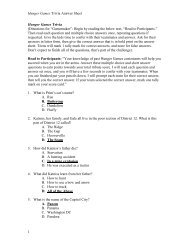Climate Change Presentation PDF
Climate Change Presentation PDF
Climate Change Presentation PDF
- No tags were found...
You also want an ePaper? Increase the reach of your titles
YUMPU automatically turns print PDFs into web optimized ePapers that Google loves.
1nsstc.uah.edu
• Greenhouse Gas Levels Increased•<strong>Change</strong> In Earth’s <strong>Climate</strong>•<strong>Change</strong>s in Marine Ecosystemshttp://umarsiddiqi.com/images/industry.jpg 2
1. Thermohaline Circulation2. Sea Level3. Temperate Nearshore Habitats4. Coral Reefs5. Antarctic Food Webs6. Arctic Species3http://www.cs.unm.edu
•NutrientsUpwelling• Dissolved Oxygen4www.ngdc.noaa.gov
• Rising fastest in 3000 years•Thermal Expansion(expanding due to increased temperature)•Added freshwater: harm stenohalineorganisms (can’t adapt to changes insalinity)http://www.economist.com/images5
•Interrupt Thermohaline Circulation• Rise 9-29 cm by 2046• Rise 28-38 cm by 2096•Melting of Glaciers and Ice Caps6
• Depend on AlgaeAlgae:1.Light2.Salinity3.Temperature4.Wave ActionRising Sea Levels:•Alter Salinity•Decrease inStenohaline OrganismsIncreased wave stressFragile species decline7www.murrieta.k12.ca.us
Rising Sea Temperature:1. Species adapt quicklyMove towards polesDisplace native species2. Species can’t adaptHigh mortality rates8http://www.californiacoastaltrail.info
Monterey Bay, California Intertidal Communities:• Data compared from 1930-1933 and 1993-1994• 8/9 Warm water species increased• 5/8 Northern species decreased9http://www.californiacoastaltrail.info
• Tropical waters, poornutrient content• Millions of organismsdepend on coral reefs10www.coralreefecosystems.com
http://www.koralsiden.dk/Art/Pocillopora-damicornis• Nine species ofcrustaceansdepend solely onlace coral.11
www.howardhall.comwww.reeffutures.org•• water • above 1-2ºC higherfor 3-5 weeks• zooxanthellae living incoral die•coral appears whitemembers.aol.com12Walther, Gian-Reto et. al. 2002
• 1979-2002 mass coral bleaching• 1997-1998 about 16%Reef-buildingcoral died• By 2030-2050 coral bleaching annualhttp://www.marine.uq.edu.au 13
• By 2100 sea temps 1-2º C greater for 40weeks• 100% of coral reefs could diehttp://www.extreme-evasion.com/ 14
• Corals: trouble moving to cooler waters•Slow-growing•Difficult to acclimatehttp://www.deepseaimages.com15http://www.wildlifesail.org
<strong>Climate</strong> change occurs faster16www.leatherwoodonline.com
17news.bbc.co.uk
• Increasingly more ice melt• More freshwater• Difference in salinity and density18http://thundafunda.com/
• Ross Sea decreased salinitypast 40 years• Weaken ThermohalineCirculation• Stenohaline organisms perish19http://picasaweb.google.com/
20http://web.pdx.edu
• Pack Ice declinedsince 1984•Krill feed onmicroalgae onpack ice• Densities of Krill lowhttp://www.bytelevel.com21mywebpages.comcast.net
• Declined by 70%since 1987• Decreased by 50%22
• Decrease in ice• Decrease in Ice Albedo23www.fjmc.ca
•Seals: build lairs toprotect their young• Snowmelt 3 weeksearlier in 1999-2001than in 1998• Pups susceptible tohypothermia andpredationhttp://www.espacepourlesespeces.ca 24
http://www.dailykos.com/• Leave pups on ice while forage• Eat bottom-dwelling organisms• Water less than 100m25
•Beafort and Chukchi sea ice edges retreating• Decrease forage areas• Lower reproductive success26en.wikipedia.org
• Broad effects on Marine Ecosystems•More research to increaseknowledge• Prepare for changes27www.palomar.edu
28http://www.alaskasaltwaterlodge.com
Karl., T. R., and K. E. Trenberth (2003). Modern globalclimate change. Science 302:1719-1723.Lovejoy and Hannah (2005). <strong>Climate</strong> <strong>Change</strong> andBiodiversity .Sturm et al. (2001). Increasing shrub abundance in theArctic. Nature 411:546-7.Walther et al. (2002). Ecological responses to recentclimate change. Nature 416:389-395.29http://www.therefinishingtouch.com/






